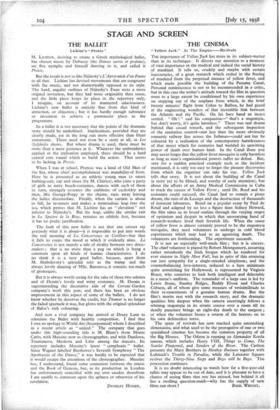THE BALLET
STAGE AND SCREEN
Lichine's " Protee"
M. LICHINE, desiring to create a Greek mythological ballet, has chosen music by Debussy (the Danses sac,* et profane), set five nymphs and himself dancing to it, and called it Protie.
But the result is not so like Nijinsky's L'Apre:s-midi d'un Faune as all that. Lichine has devised movements that are congruent with the music, and not diametrically opposed to its style. The hard, angular outlines of Nijinsky's Faun were a more original invention, but they had more originality than sense, and the little piece keeps its place in the repertory only, I imagine, on account of its mannered salaciousness. Lichine's new ballet is entirely free from that kind of attraction, or objection ; but it has hardly enough substance or invention to achieve a permanent place in the programme.
In a ballet it is not necessary that the points of the dramatic story should be underlined. Implications, provided they are clearly made, are in the long run more effective than blunt statements. There need not even be a story at all, as Les Sylphides shows. But where drama is used, there must be more than a mere pretence at it. Whatever the embroideries applied or the stylisation employed, there should be a hard central core round which to build the action. That seems to be lacking in Protee.
When I was at school, Proteus was a kind of Old Man of the Sea, whose chief accomplishment was mutability of form. Here he is presented as an athletic young man in smart bathing-suit, cap and shoes (by M. Chirico), who joins a party of girls in natty beach-costumes, dances with each of them in turn, strangely assumes the emblems of cuckoldry and then, like Georgy-Porgy in the rhyme, runs away ledving the ladies disconsolate. Finally, when the curtain is about to fall, he re-enters and makes a tremendous leap into the sea, which proves that M. Lichine has an " elevation" not inferior to Nijinsky's. But the leap, unlike the similar exit in Le Spectre de la Rose, remains an athletic feat, because it has no poetic justification.
The fault of this new ballet is not that one cannot say precisely what it is about—it is impossible to put into words the real meaning of La Concurrence or CotiUon—but that it fails to create the mood at which it evidently aims. La Concurrence is not merely a tale of rivalry between two dress- makers ; that is no more than a peg on which is hung a comment upon all kinds of human characteristics. I do no think it is a very good ballet, because, apart from M. Shabelevsky's splendid solo as the tramp and the always lovely dancing of Mlle. Baronova, it consists too much of grotesques.
But it is always worth seeing for the sake of those two soloists and of Derain's lovely and witty costumes. M. Derain is superintending the decorative side of the Covent Garden company's work this year, and there has been an obvious improvement in this aspect of some of the ballets. I do not know whether he deserves the credit, but Thamar is no longer the faded spectacle it was, but glows with the original splendour of Bakst's rich colouring.
And now a rival company has arrived at Drury Lane to stimulate the Ballet with healthy competition. I find that I owe an apology to World Art (Incorporated) whom I described in a recent article as " united." The company that goes under this high-sounding title is M. Blum's from Monte Carlo, with Massine now as choreographer, and with Danilova, Toumanova, Merkova and Lifar among the dancers. Its repertory includes Massine's latest " symphonic " ballet. Since Wagner labelled Beethoven's Seventh Symphony " The Apotheosis of the Dance," it was hardly to be expected that it would escape the attentions of the choreographer. Massine has, I understand, found some connexion between the music and the Book of Genesis, but, as its production in London has unfortunately coincided with my own exodus therefrom I am unable to comment upon the aptness or otherwise of his revelation.
DYNELEY HUSSEY.










































 Previous page
Previous page